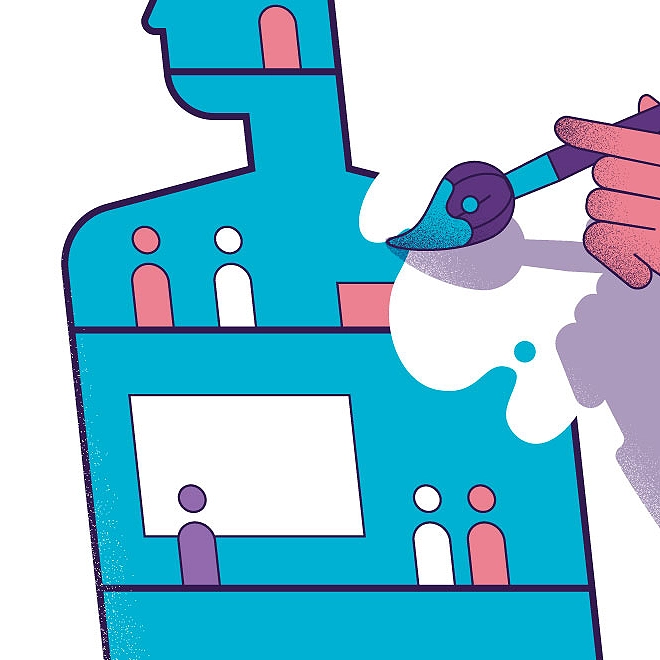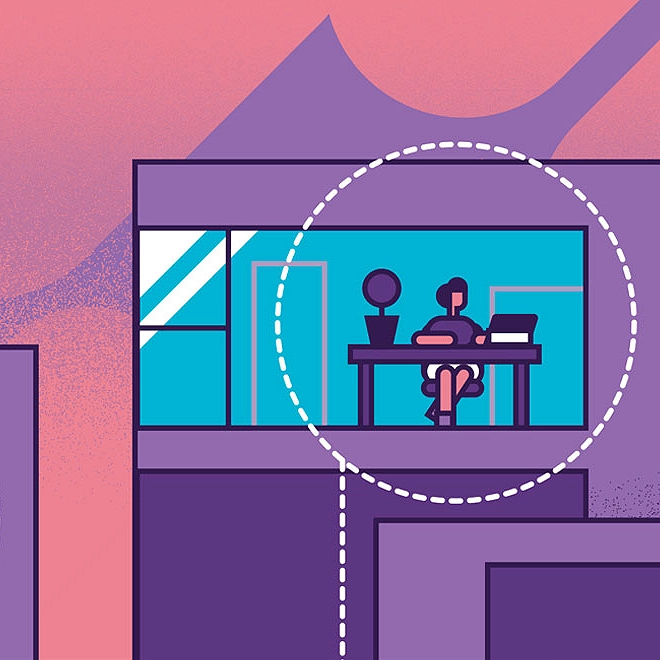Introduction: Leading the social enterprise—Reinvent with a human focus
2019 Global Human Capital Trends
IN 2019, an intensifying combination of economic, social, and political issues is challenging business strategies. Faced with the relentless acceleration of artificial intelligence (AI), cognitive technologies, and automation, 86 percent of respondents to this year’s Global Human Capital Trends survey believe they must reinvent their ability to learn. After nearly 10 years of economic growth,1 and despite a pervasive corporate focus on digital transformation, 84 percent of respondents told us they need to rethink their workforce experience to improve productivity. And in the face of new pressures to move faster and adapt to a far more diverse workforce, 80 percent believe they need to develop leaders differently.
What is a social enterprise?
A social enterprise is an organization whose mission combines revenue growth and profit-making with the need to respect and support its environment and stakeholder network. This includes listening to, investing in, and actively managing the trends that are shaping today’s world. It is an organization that shoulders its responsibility to be a good citizen (both inside and outside the organization), serving as a role model for its peers and promoting a high degree of collaboration at every level of the organization.
While these may seem like timeless human capital problems, today they are arising in a whole new context: the social enterprise. In last year’s Global Human Capital Trends report, we described the rise of the social enterprise—organizations whose mission combines revenue growth and profit-making with the need to respect and support its environment and stakeholder network. This year, we believe the pressures that have driven the rise of the social enterprise have become even more acute. They are forcing organizations to move beyond mission statements and philanthropy to learn to lead the social enterprise—and reinvent themselves around a human focus.
Leading the social enterprise
When CEOs were asked to rate their most important measure of success in 2019, the number-one issue they cited was “impact on society, including income inequality, diversity, and the environment,”2 showing the urgency of this issue (figure 1).

But while CEOs have recognized the issue, they certainly haven’t solved for it. That’s because leading a social enterprise is not the equivalent of practicing corporate social responsibility. Nor is it about engaging in social impact programs or defining a purpose or mission statement—though all of these are also important in their own right. Leading a social enterprise is about recognizing that, while businesses must generate a profit and deliver a return to shareholders, they must do so while also improving the lot of workers, customers, and the communities in which we live. And in today’s world, with today’s societal challenges, fulfilling this aim requires reinvention on a broad scale.
We are not alone in this view. Deloitte’s global research on leadership in the Fourth Industrial Revolution underscores the value CEOs and business leaders place on societal impact and connection, and its importance in measuring success when evaluating annual business performance.3 And this year’s Global Human Capital Trends survey, which polled nearly 10,000 respondents in 119 countries, not only confirmed this trend by showing accelerating growth in the role of the social enterprise (figure 2), but also supported the social enterprise’s positive link to financial performance (figure 3).


Reinvent with a human focus
There is no question that the Fourth Industrial Revolution is bringing disruption to the political, economic, and social fabric—and this disruption is having an impact on work, workers, and employers as never before. Issues such as income inequality, wages, and the role of businesses in society are all under debate, and the tensions underlying the social enterprise are being reflected in labor, regulatory, and community concerns around the world. For example, in 2018, the United States experienced 20 major work stoppages involving 485,000 workers—the most since 2007—with strikes in the education sector by far the most frequent.4 Meanwhile, after more than 40 years of nominal pay growth in the United States, purchasing power after adjusting for inflation has barely budged.5 Income inequality has increased in many developed economies, including the United States, where the bottom 90 percent of earners have only seen a 5 percent wage increase in the last 18 years,6 and in China, where income inequality has grown rapidly.7
The magnitude of the disruptions to work, workers, and the workforce—and their consequent impact on employers—are why we have deliberately chosen the word “reinvent.” Reinvention goes back to the core—the foundation of an organization. This is not about tinkering at the edges. Why? Because with regard to work, the workforce, and the workplace, there is much work to be done. Eighty-five percent of employees around the world are not engaged or are actively disengaged from their jobs.8 People are working more hours, and problems of financial and mental stress seem to be at a peak. Some experts attribute the high suicide rate among young men in Japan to an increase in “precarious employment,” in which young people are employed on short-term contracts.9 Yet in the United States, more than 40 percent of the workforce now works on a contingent basis,10 and more than two-thirds of millennial and Generation Z workers work “side hustles” to help make ends meet.11 More than 50 percent of respondents to this year’s Global Human Capital Trends survey told us that they thought their employees would have an easier time finding a new job with a new employer than within their current organization. And research now shows that the No. 1 reason people quit their jobs is the “inability to learn and grow.”12
Demographic changes are also driving a rethinking of who, exactly, employers need to engage for work. The birth rate in many developed countries is below replacement level13 (in both the United States and the United Kingdom, the fertility rate is 1.9 children per woman),14 and the fastest-growing segment of the workforce in the United States is now those above age 55.15 Societies have benefited from an increase in life expectancy through the science of health, but we aren’t sure what jobs, careers, or roles workers should have in these longer lives.
Finally, as automation becomes more prevalent in the workplace, we see a need to put meaning back into work. Whether it’s algorithms figuring out what tasks workers should perform, nudges encouraging workers to behave a certain way, or data indicating who a worker is and what matters to them, technology has not only invaded the workplace, but is shaping and monitoring individuals’ identities at work. In many ways, technology has leaped ahead of leaders and organizations, and the human element needs to catch up.
To help guide organizations through the reinvention, we posit a set of human principles for the social enterprise (figure 4). These five principles frame the “human focus” for the social enterprise and serve as benchmarks against which we can measure any action or business decision that could potentially affect people. Because the paradox of today is that while we live in a world of amazing technology, it is—and always will be—human potential that moves us forward.

2019’s 10 human capital trends
The five design principles for the social enterprise give us the why for reinvention. But where can we direct our efforts in order to make a meaningful impact? To address this question, we have organized our human capital trends for 2019 into three actionable categories. The first deals with the future of the workforce: how organizations should adapt to the forces restructuring job and work design, the open talent economy, and leadership. The second deals with the future of the organization: how teams, networks, and new approaches to rewards are driving business performance. And the third deals with the future of HR: how the function is stepping up to the challenge of redesigning its capabilities, technologies, and focus to lead transformation in HR and across the enterprise.
The future of the workforce
The alternative workforce: It’s now mainstream. For years, many considered contract, freelance, and gig employment to be “alternative work,” options supplementary to full-time jobs. Today, this segment of the workforce has grown and gone mainstream even as talent markets have tightened, leading organizations to look strategically at all types of work arrangements in their plans for growth. Best practices to access and deploy alternative workers are just now being invented. If the economy continues to grow, organizations must be more flexible in adapting to these new work arrangements, and plan to use them in a strategic way.
From jobs to superjobs. A vast majority of organizations told us they expect to increase or significantly increase their use of AI, cognitive technologies, robotic process automation, and robotics over the next three years. As organizations adopt these technologies, they’re finding that virtually every job must change, and that the jobs of the future are more digital, more multidisciplinary, and more data- and information-driven. Paradoxically, to be able to take full advantage of technology, organizations must redesign jobs to focus on finding the human dimension of work. This will create new roles that we call “superjobs”: jobs that combine parts of different traditional jobs into integrated roles that leverage the significant productivity and efficiency gains that can arise when people work with technology.
Leadership for the 21st century: The intersection of the traditional and the new. Developing leaders is the perennial issue of our time. Eighty percent of survey respondents told us that leadership was an important or very important issue, and 80 percent of respondents said that “21st-century leaders” face unique and new requirements. To be effective in the 21st century, leaders must take a nuanced approach to pursuing traditional business goals: an approach that takes into account the new context in which such goals must be achieved, and that draws on critical new competencies—including leading through change, embracing ambiguity and uncertainty, and understanding digital, cognitive, and AI-driven technologies—to get there.
The future of the organization
From employee experience to human experience: Putting meaning back into work. One of the biggest challenges we identified this year is the need to improve what is often called the “employee experience”: Eighty-four percent of our survey respondents rated this issue important, and 28 percent rated it urgent. But the concept of employee experience falls short in that it fails to capture the need for meaning in work that people are looking for. We see an opportunity for employers to refresh and expand the concept of “employee experience” to address the “human experience” at work—building on an understanding of worker aspirations to connect work back to the impact it has on not only the organization, but society as a whole.
Organizational performance: It’s a team sport. The shift from hierarchies to teams is well underway. Thirty-one percent of survey respondents told us they now operate mostly or almost wholly in teams, with another 65 percent saying they are mostly hierarchical but with some cross-functional team-based work. Yet most organizations have not yet refreshed leadership, job design, and rewards to adapt. Our research shows that many leaders do not know how to operate in teams and have not yet adopted the team model of engaging with each other. Deeper in the enterprise, many organizations are still struggling to build programs and incentives that support teaming as well. In 2019, technology is making team models of work easier: Organizations must now refresh the rest of our talent practices to keep up.
Rewards: Closing the gap. Organizations are exploring a dizzying array of perks and rewards to motivate their people. But they are not keeping up: In our 2019 survey, only 11 percent of respondents told us their rewards systems were highly aligned with their organizational goals, and 23 percent reported that they did not know what rewards their workers value. How can organizations develop rewards that align with more agile models for performance measurement and management, and at the same time address workers’ legitimate expectations and needs? A focus on building relationships with workers—and eschewing external benchmarking in favor of curating a differentiated suite of rewards—can help organizations close the gap.
The future of HR
Accessing talent: It’s more than acquisition. In this 11th year of the economic recovery, recruiting has become harder than ever. As the job market remains competitive and organizations’ skills requirements undergo rapid change, it’s time for organizations to think about how they can continuously “access talent” in varying ways: mobilizing internal resources, finding people in the alternative workforce, and strategically leveraging technology to augment sourcing and boost recruiting productivity.
Learning in the flow of life. The number-one trend for 2019 is the need for organizations to change the way people learn; 86 percent of respondents cited this as an important or very important issue. It’s not hard to understand why. Evolving work demands and skills requirements are creating an enormous demand for new skills and capabilities, while a tight labor market is making it challenging for organizations to hire people from outside. Within this context, we see three broader trends in how learning is evolving: It is becoming more integrated with work; it is becoming more personal; and it is shifting—slowly—toward lifelong models. Effective reinvention along these lines requires a culture that supports continuous learning, incentives that motivate people to take advantage of learning opportunities, and a focus on helping individuals identify and develop new, needed skills.
Talent mobility: Winning the war on the home front. As organizations globalize and compete aggressively for top talent, the importance of internal, enterprisewide talent mobility has become paramount. Organizations can no longer expect to source and hire enough people with all the capabilities they need; they must move and develop people internally to be able to thrive. A new set of norms governing internal mobility is needed to do this well. At leading organizations, mobility should be perceived as a natural, normal progression instead of as a major change in one’s career; opportunities to move should be extended to workers at all levels, not just managers and team leaders; and technology should enable a streamlined mobility process for moves between functions, jobs, and projects as well as geographies.
HR cloud: A launch pad, not a destination. Cloud computing has gone mainstream, and organizations have spent millions on new platforms to make HR systems more engaging, personalized, and data-driven. Yet while cloud systems have gone a long way toward integrating the messy back office of HR, they aren’t all that's needed to better support innovation, raise employee productivity, and lower cost. In 2019, organizations must rethink their HR technology strategy, considering cloud as a foundation and exploring innovative new platforms, automation, and AI-based tools to complement their core systems.
We recognize that reinvention can be a daunting prospect, especially when our survey shows that many organizations are not ready to address the changes our 10 trends describe (figure 5). That is why, this year, we have focused not only on the why and the what, but also the how. Depending on your organization’s readiness and need to change, reinvention can happen in one of three ways. You can refresh: Update and improve the way things happen now. You can rewire: Create new connections that change the strategic direction. Or you can recode: Start over and design from scratch. Either way, there are two aspects of the reinvention that remain constant: (1) it must involve technology in some way—there is no path to reinvention without it and (2) it must be a bold enough change to meet the challenges that the social enterprise presents; remember, this is not about tinkering at the edges.

In each of the following chapters, you will find one of these three modes of reinvention noted as a suggested starting point. Which of these efforts is best to undertake in which domain for any particular organization is a conversation for leaders across the enterprise to have (figure 6). But regardless of the path taken, the aim should remain constant: a renewed human focus in a world where profits meet purpose, talent trumps technology, and the social enterprise reigns supreme.

Human Capital Consulting
Deloitte's Human Capital professionals leverage research, analytics, and industry insights to help design and execute the HR, talent, leadership, organization, and change programs that enable business performance through people performance.



